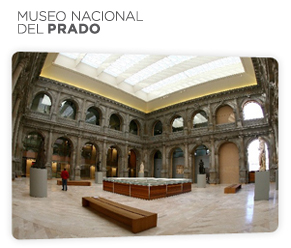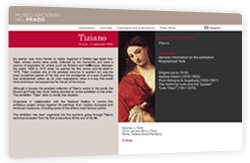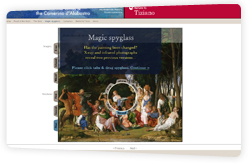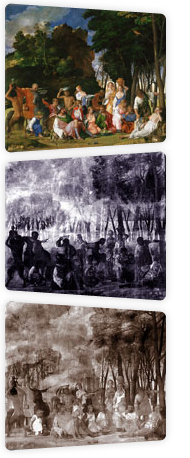There are gender wars, and then there are casualties. It wasn’t until 2011 that the behemoth toymaker LEGO acknowledged girls’ desire to build with bricks, even though the company had long before made a seemingly effortless pivot to co-branding, video games, and major motion pictures. So it’s little wonder that girls face all-too-real obstacles when […]
Read more Prado, Madrid
Prado, Madrid
In 2003, Museo del Prado had a major exhibit on Titian, the leader of the 16th century Venetian school of Italian Renaissance painters. Organized in collaboration with the National Gallery in London, this ambitious project brought together 65 paintings from various European and American museums that were commissioned by the Duke of Ferrara.
- See IDEA’s WebExhibits Feast of the Gods bilingual collaboration with the Prado.
- See IDEA’s WebExhibits Feast of the Gods full exhibit.

“Primary exhibit Prado, 2003”
IDEA collaborated with Blanca Sánchez Velasco, Gabriele Finaldi, and Miguel Falomir to adapt a portion of Bellini’s Feast of the Gods WebExhibit into a bilingual presentation (translated by Juan Silva) that included reconstructed views of earlier versions by Bellini and Dosso Dossi.

“Complementary mini-exhibit Webexhibits”
To make the complex, multi-dimensional data easily accessible, IDEA developed innovative data display tools for visitors to use. For example, by simply placing the cursor over one part of the painting, information specific to that area became available, including the exact paint that was used and what an X-ray of the area revealed. Visitors could also zoom in to view sections of the painting for detailed study, and use a “spyglass” to compare an X-ray or infrared image to what’s seen with the naked eye. The classic style, rich colors, and textured backgrounds brought the masterpiece and its mysteries to life.
 The exhibit also included a virtual reconstruction of Alfonso d’Este, the Duke of Ferrara’s private art gallery, or camerino. At the time, such 3D virtual worlds were new technologies, and provided visitors with a deeper understanding of how the paintings related to one another when they were hung in the original gallery in the 1530s.
The exhibit also included a virtual reconstruction of Alfonso d’Este, the Duke of Ferrara’s private art gallery, or camerino. At the time, such 3D virtual worlds were new technologies, and provided visitors with a deeper understanding of how the paintings related to one another when they were hung in the original gallery in the 1530s.
The Prado described the significance of the exhibit as both a reflection of the artist’s work and the relationship between the artist and the Spanish monarchy:
Tiziano is the most extensive exhibition devoted to the artist’s work since the one held in Venice in 1935, and the first monographic exhibition dedicated to his work in Spain. H.R.H. the Prince of Asturias and the vice-president of the Italian Government, Gianfranco Fini opened the exhibition on June the 9th. Featuring a total of 65 works, it includes more than 30 paintings that have never previously been seen in Spain, such as the Venus of Urbino, which is shown outside Italy for the first time in its history.Between 1508 and 1510, the years when he produced his first works, and his death in 1576, Titian created one of the greatest oeuvres in western art, was the most acclaimed painter of his day and the protagonist of a type of painting that emphasised colour as its main expressive value in a way that would have enormous consequences for the art of the future. The Museo del Prado has the finest collection of works by the artist as a result of his unique relationship with the Spanish monarchy. It has now organised this monographic exhibition, one of the most complete ever to be devoted to the artist, comprising 65 paintings organised into five sections. These include the Venus of Urbino (Florence, Galleria degli Uffizi), Salomé (Rome, Galleria Doria Pamphili), La Schiavona (London, The National Gallery), Man with a Glove (Paris, Musée du Louvre), Tarquin and Lucretia (Cambridge, The Fitzwilliam Museum), The Flaying of Marsyas (Kromeriz, Archbishop’s Palace), as well as the masterpieces by the artist in the Museo del Prado’s permanent collection. Giovanni Bellini’s Feast of the Gods (Washington D.C., National Gallery of Art), which formed part of the spectacular group of mythologies that Titian painted for the Camerino d’Alabastro in the Ducal palace in Ferrara, will be one of the highlights of the exhibition.
The close relationship between Titian and the paintings that make up the Museo del Prado’s collection is the direct result of his favoured status with the Spanish monarchy. This means that at the same time that the exhibition is taking place, the Museum also offers the visitor the opportunity to see works by the two greatest heirs to the tradition of the artist: Rubens and Velázquez, a privilege that no other museum can offer.
The exhibition curator, Miguel Falomir, Head of Department of Italian Renaissance Painting at the Museo del Prado, has devised an exhibition which combines a chronological arrangement (allowing for an analysis of Titian’s stylistic development and his use of innovative narrative techniques) with sections devoted to his working practices.

